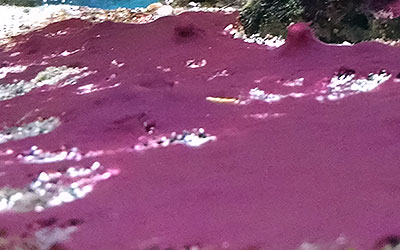Cyanobacteria, also referred to as “red slime”, is an issue a lot of reefers get to deal with sooner or later. It can be one of your start up symptoms, but it can also appear in a well established tank. But what is it exactly, where does it come from and how to get rid of cyanobacteria?
3.5 billion year old fossils
As the name suggests, red slime or cyanobacteria are… yes, bacteria. They are photosynthetic what basically means they can manufacture their own food if provided with enough light. Although they played a very important part in the evolution of our earth (their origin goes back more than 3.5 billion years!) , they are not really being considered to be a welcome guest in our reef tanks.
Why? When they grow into large colonies they form a red or bright green slime, mostly in well lit places… and yup, this can really mess up the beauty of our masterpieces.

Yeah, but no, but yeah…
Where cyanobacteria come from, or what might be the specific reason it shows up in your tank, still leaves a lot of room for speculation. Too high nitrate and phosphate levels are pointed out as the main causes, but also too low nitrate and phosphate levels… so basically, an unbalance in nitrate or phosphate levels. Other reasons range from too hot water, too much light, not enough bacterial strains, not enough flow,… make your pick.
Kill it with fire!
Well, maybe not… but let’s take a look at effective ways to get rid of cyanobacteria. As it is difficult to determine why the cyanobacteria showed up, finding the right way to fight it will be a challenge, but here are some effective ways to get rid of it.
- Suck it out with a hose. Actually, whatever way you prefer, combine it with this one.
- Leave the lights off for some time (and again suck it out in the meantime) or reduce your lighting schedule. It will limit the cyanobacteria growth as you take away their main food source.
- Limit your feeding schedule to once every 2 days and try to target feed as much as possible so leftover foods cannot cause an unbalance in your parameters.
- Redirect flow in low flow areas.
- Up your water change routine back to weekly water changes if you aren’t doing this already. (and suck out the cyano while at it)
- Buy a Tiger sand conch, this snail is known to eat cyano.
- Use a phosphate remover to get phosphates in the lower range. (0,03 ppm is ideal)
- Add bacterias so these “good” bacterias can compete with “bad” cyanobacteria.
- Carbon dosing: for example with the wodka method is often pointed out as a possible solution, but for me this seemed to have the opposite effect… so I wouldn’t advise it from personal experience.
- Use chemicals: although these don’t handle the causes, they can be a solution as a last resort. I always prefer to use natural ways, but that doesn’t mean people didn’t have any success with for example Red slime remover. However, take into account it is VERY important to follow the guidelines provided with any product… Do not overdose! And use at your own risk.
Keep in mind to do enough research before using chemicals as these can have possible negative effects on your tank in the future.
If you have used other successful methods to get rid of cyanobacteria, feel free to share them below and maybe I’ll add it to the list!

